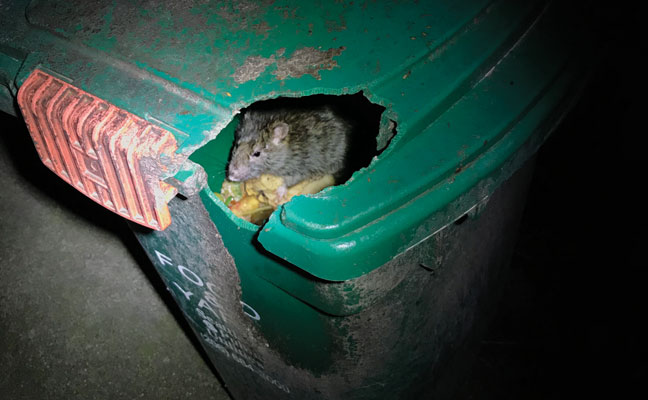
PHOTO: MARK SHEPERDIGIAN
Q: I am servicing a house in Seattle, Wash., that has a chronic problem with Norway rats (Rattus norvegicus). The city compost bins contain food waste, and are a constant source of food. Are traps better than bait in this situation?
—STRESSED IN SEATTLE
A: The short answer is no.
The long, complicated answer is that rats are a product of their environment. Traps and baits are designed to act on the rats. If you don’t change the environment, the rats will always rebound. However, the rat population cannot build any higher than the environment will allow. You cannot change an entire city, but you may be able to get cooperation from your client’s home and his or her neighbors.
If the city requires compost bins, there are several obvious approaches — and perhaps a few less-obvious ones that will require imagination.
The most obvious solution would be rat-proof bins. This means maintaining bins and replacing them when they become damaged. It may mean getting different bins, but some cities require specific units, and this could become expensive for your client.
You may suggest not putting the compost out until the day of collection, or storing the official bins in a larger, rat-proof container. There could be some other ways to cut the rats off from an endless supply of food. That alone will affect the rat population in the area. And yes, it requires the neighbors to cooperate, but the health department may be helpful in getting their attention.
In addition to reducing the amount of available food, take a hard look at the landscaping. Norway rats are tightly tied to burrows in the earth. Is there heavy ground cover? Low-slung bushes that provide cover for burrows? Rats can always find a place to burrow, but when easy ground with lots of cover is available, the population will take off.
After limiting the available food and harborage, give a careful eye to exclusion for your client’s home, and re-inspect regularly.
Now we can talk about traps and baits. Whatever you use, be sure to keep them secure and inaccessible to children and non-targets. Traps are most effective when the rats aren’t suspicious of them.
Your greatest tool will be patience. Put traps in the environment, but don’t set them until you get reliable feeding on pre-baited traps. If you set the traps before the rats are used to them, you will kill a few rats — and educate the rest of them. Like traps, you can change the styles of stations. Don’t rely on a single bait or style of trap.
Working a program for one home in a high-rat zone is a tall order, but you should be able to get favorable results by paying attention to the fundamentals.
The post Ask the Expert: Outdoor rat-proofing tips appeared first on Pest Management Professional.
from Pest Management Professional https://www.mypmp.net/2019/06/19/ask-the-expert-outdoor-rat-proofing-tips/
Sacramento CA
No comments:
Post a Comment